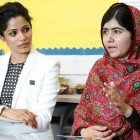September 19, 2011; Source: New York Times | The Peace Corps marked its 50th anniversary on September 22, celebrating the over 200,000 volunteers who have served in 139 countries since 1961. A new commemorative report, “A Call to Peace”, summarizes the program’s history, the viewpoints of Returned Peace Corps Volunteers (RPCVs), and recommendations for the future.
Given today’s political gridlock, it’s hard to imagine the breathtaking speed of change that marked the launch of the Peace Corps. But it’s worth remembering such things can happen, and reviving the possibility of bold, rapid policy movement in Washington among those who aren’t old enough to remember.
While the idea of a youth corps serving developing countries had floated around Washington since Harry Truman’s time, the catalyst for launching the actual Peace Corps was an October 14, 1960 campaign challenge from then Presidential Candidate John F. Kennedy to an audience of Michigan college students. Within days, University of Michigan students gathered 1000 pledges among their peers to volunteer overseas. Two weeks later, Candidate Kennedy formally proposed a Peace Corps “of men and women who would dedicate themselves to the progress and peace of developing countries” as a key element of his platform. Candidate Nixon was unwilling to endorse a similar proposal, viewing it as a “kiddie corps”.
When Kennedy took office in January 1961, he immediately established a task force, chaired by his brother-in-law Sargent Shriver, to design the Peace Corps. The task force’s work was complete in a month, and Kennedy created a temporary program by Executive Order in March. By August, the first 51 volunteers travelled to Ghana. And on September 22, 1961, Congress passed enabling legislation that formally established the Peace Corps.
Sign up for our free newsletters
Subscribe to NPQ's newsletters to have our top stories delivered directly to your inbox.
By signing up, you agree to our privacy policy and terms of use, and to receive messages from NPQ and our partners.
Peace Corps originally had three goals: “helping people from interested countries meet their need for trained men and women, helping promote a better understanding of Americans on the part of peoples served, and helping promote a better understanding of other peoples on the part of Americans”. It also included five different “channels of growth” with a variety of time commitments and partners. The present day Peace Corps is the only channel that was fully implemented.
The report shows how Peace Corps has changed over time in terms of project focus, geography and the volunteer demographics. The report also includes detailed analysis of how RPCVs view their impact across the three goals, and what program changes they’d support in the future. More recent RPCVs are more critical of Peace Corps, yet also the most opposed to changing key program elements such as term of service or oversight. Most tellingly, however, across all five decades of volunteers, 98% would recommend participation to a child, grandchild or other close family member.
What would it take to move a similarly big idea forward once again today?—Kathi Jaworski













